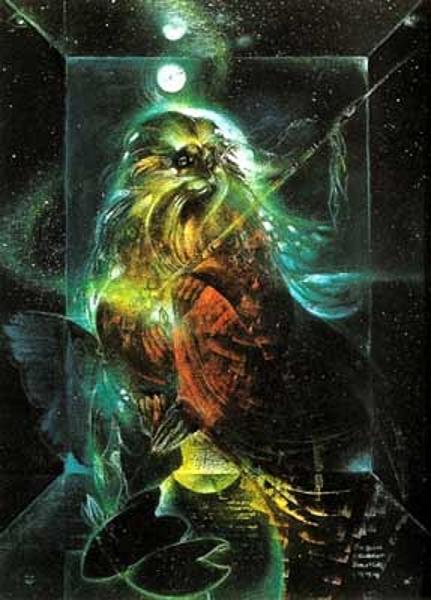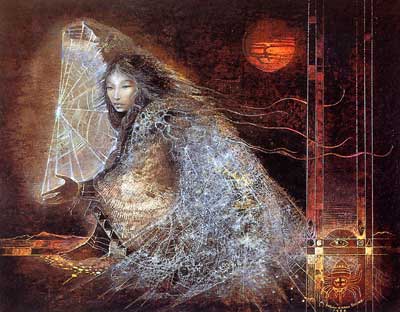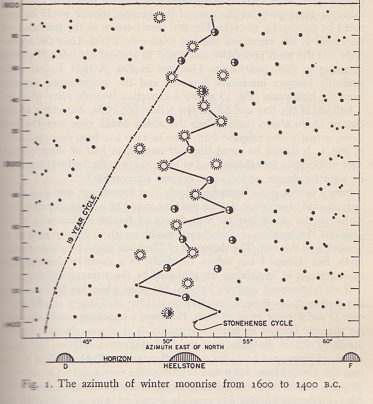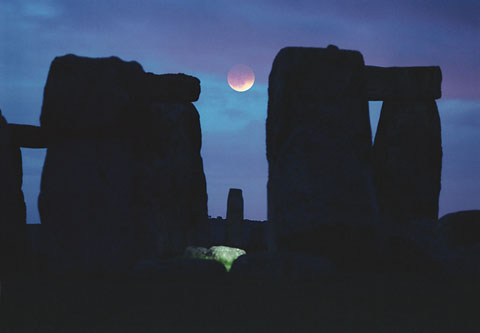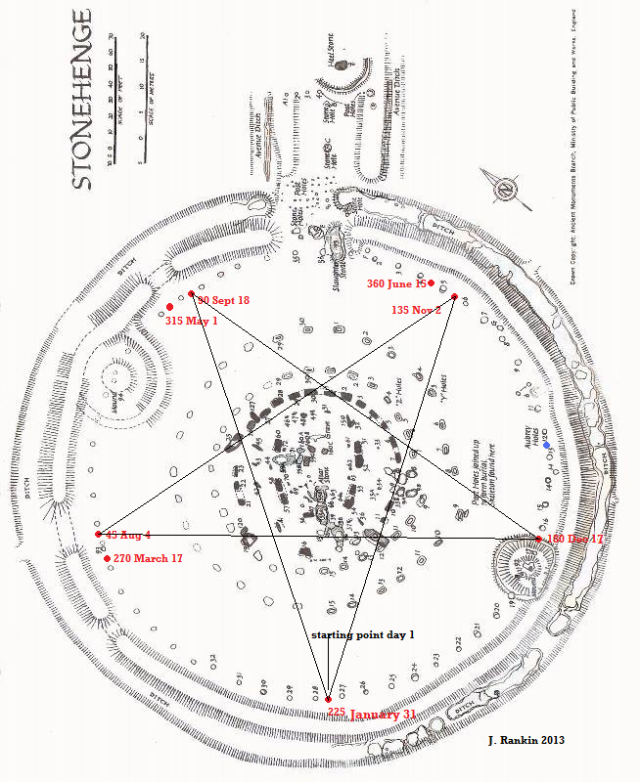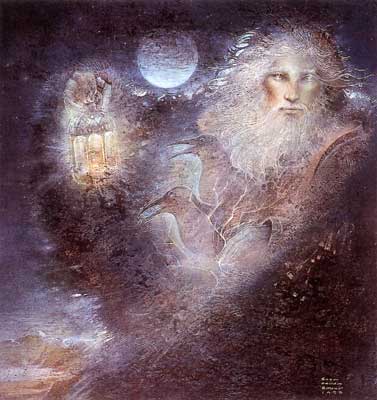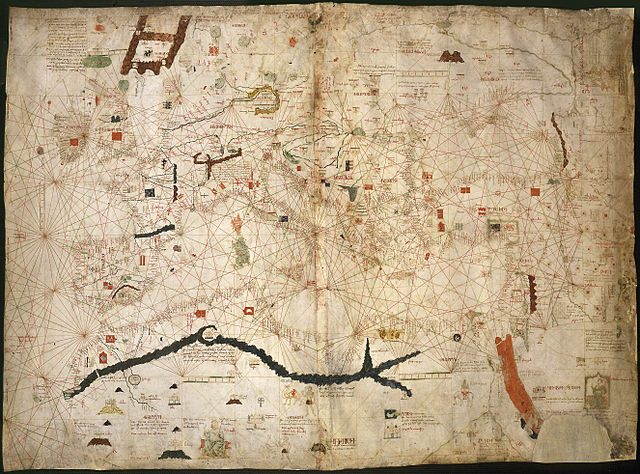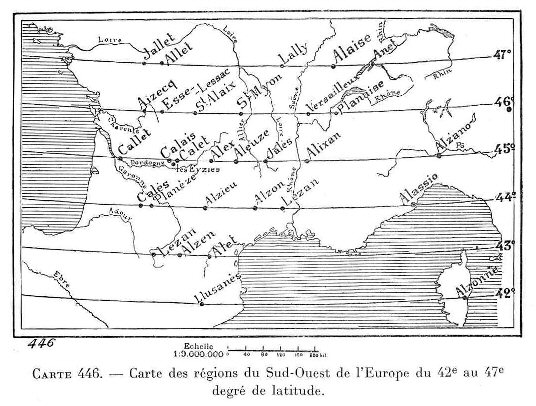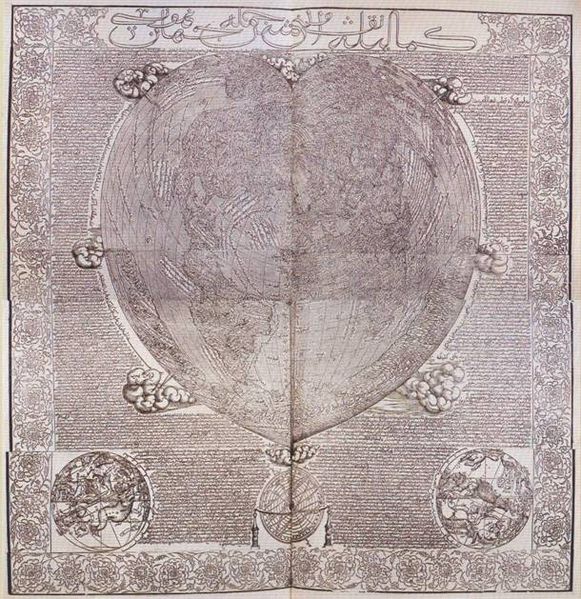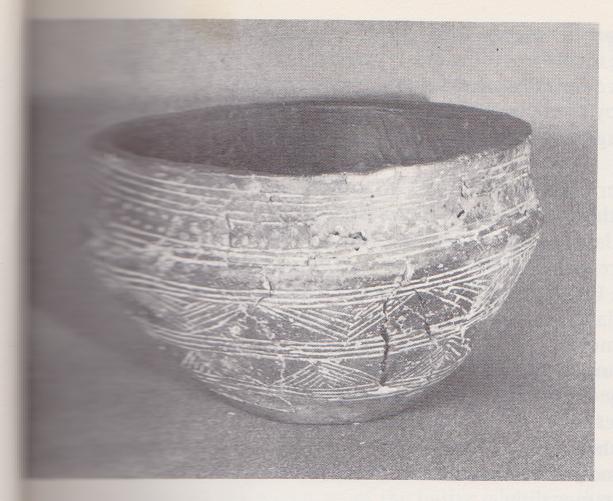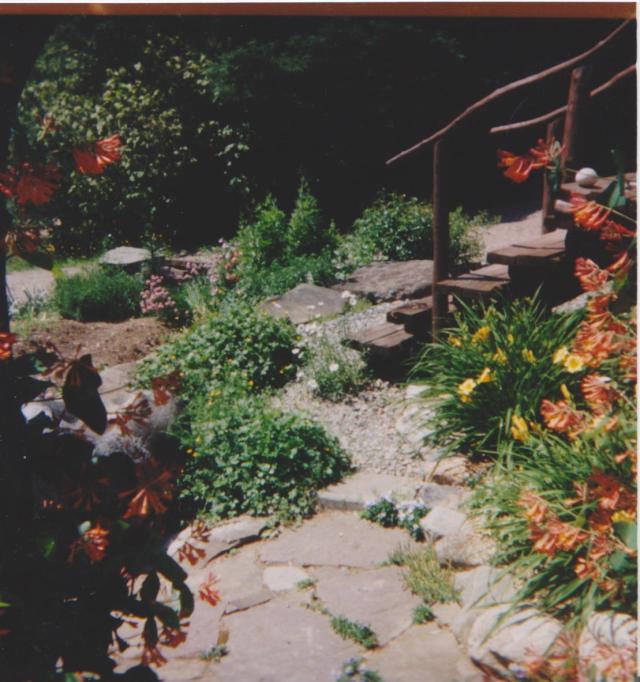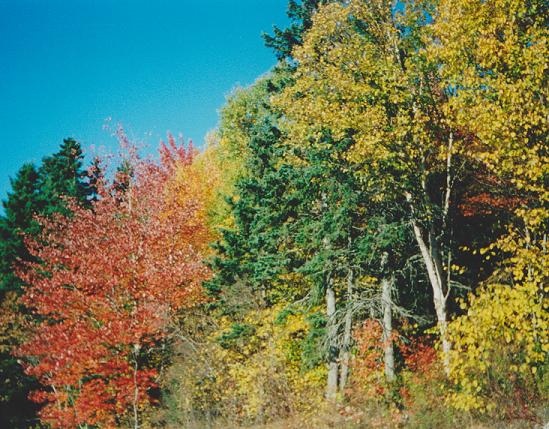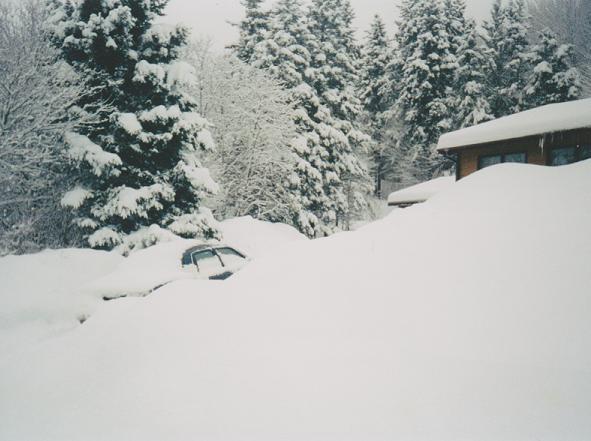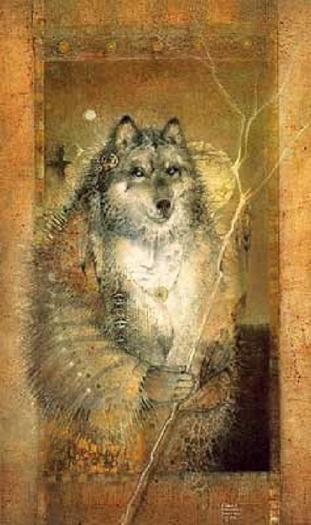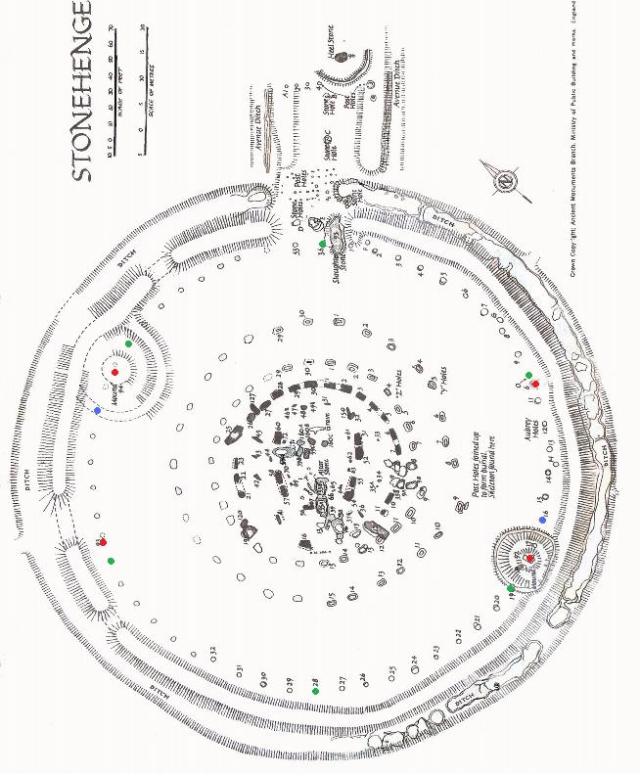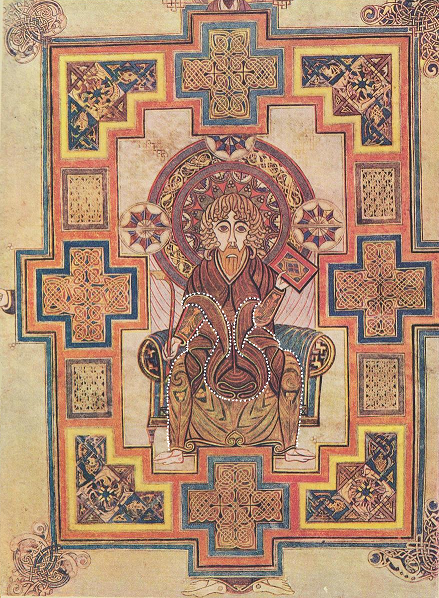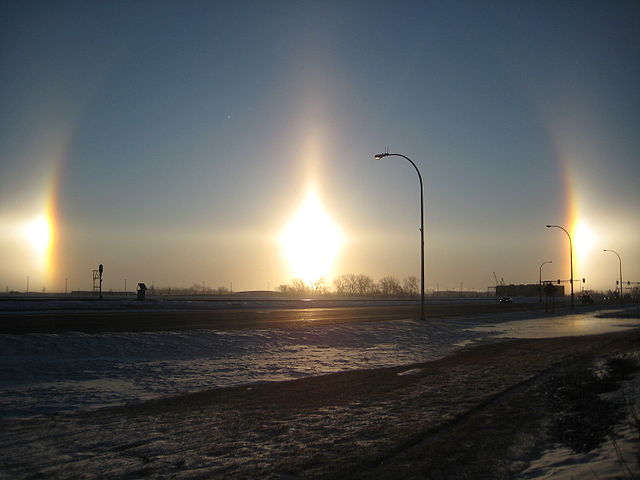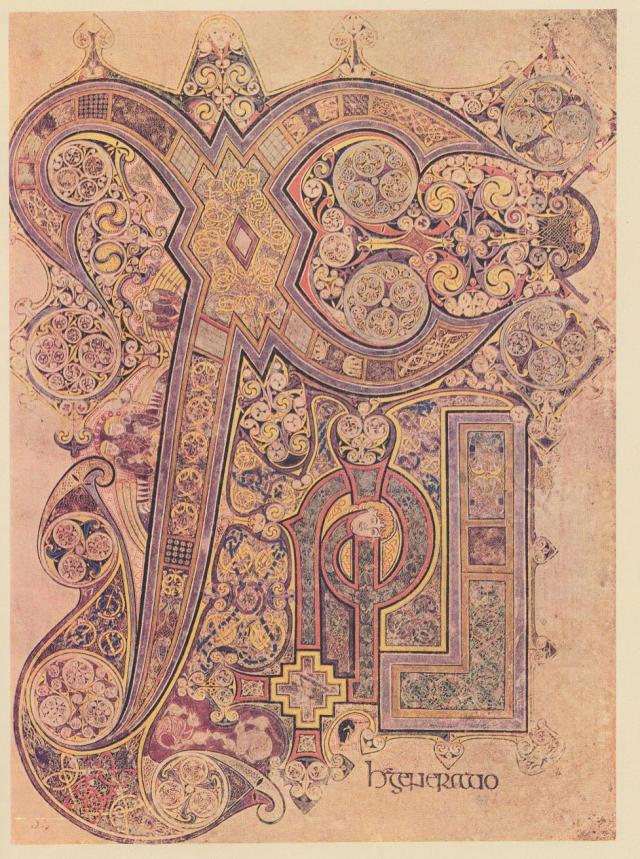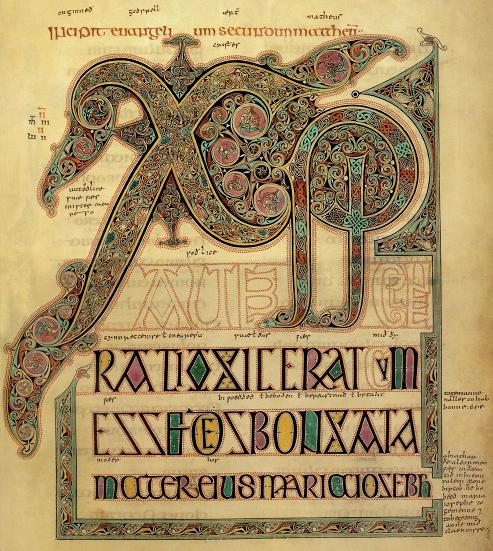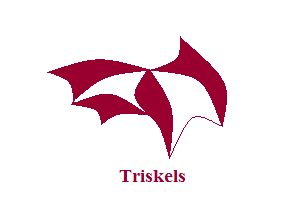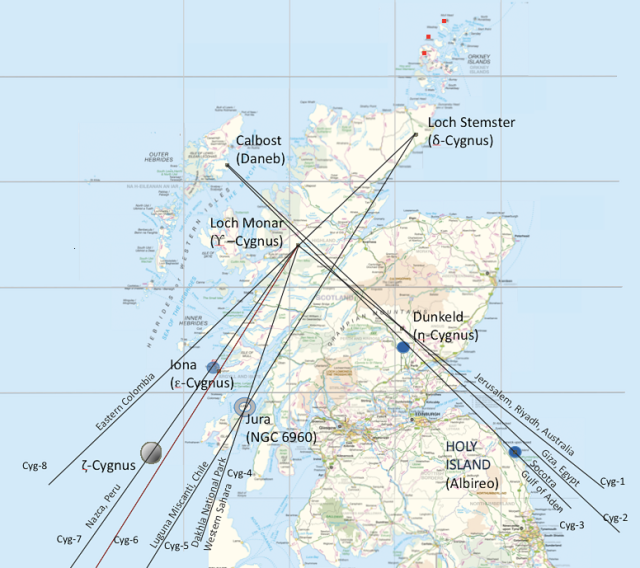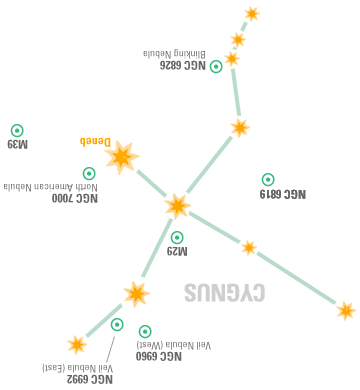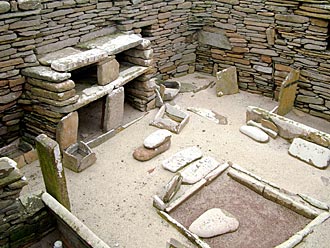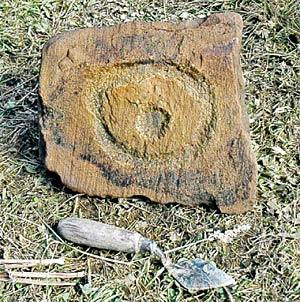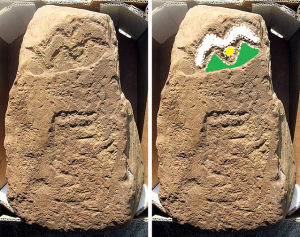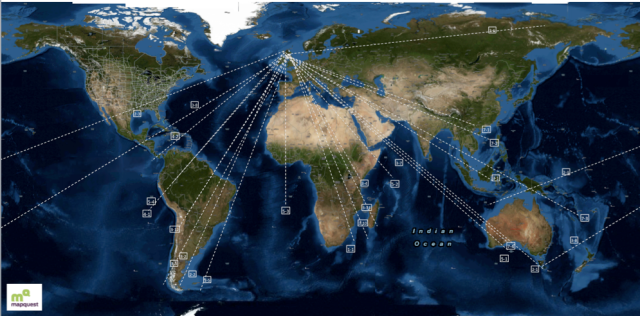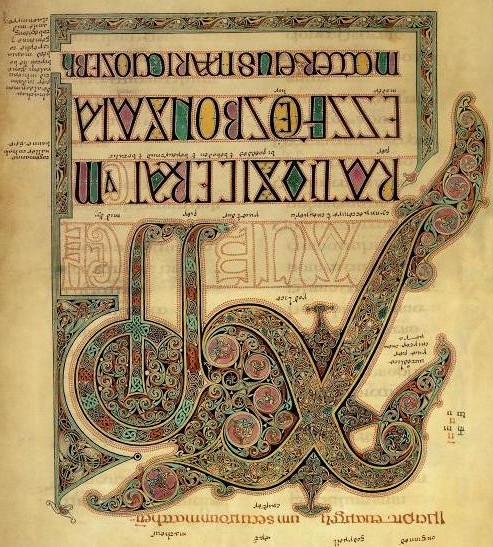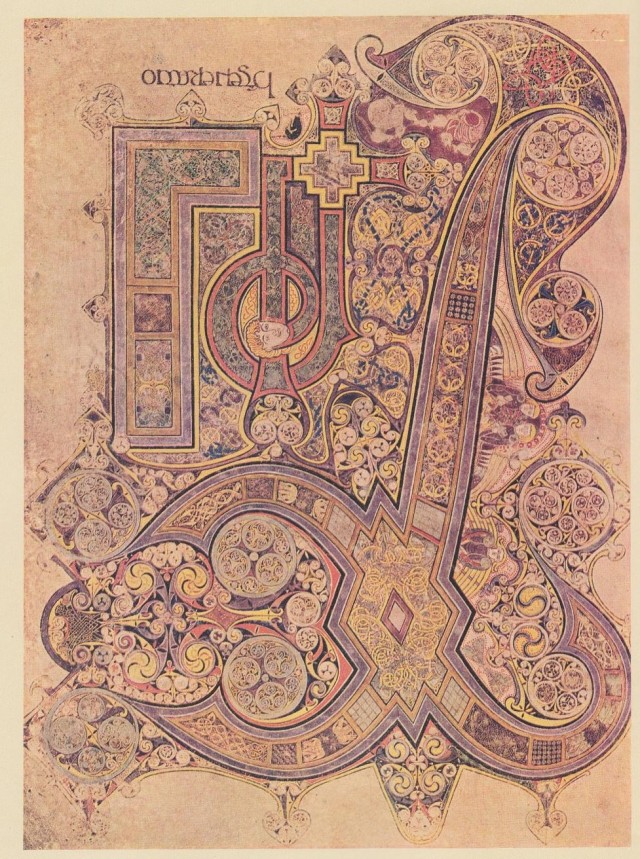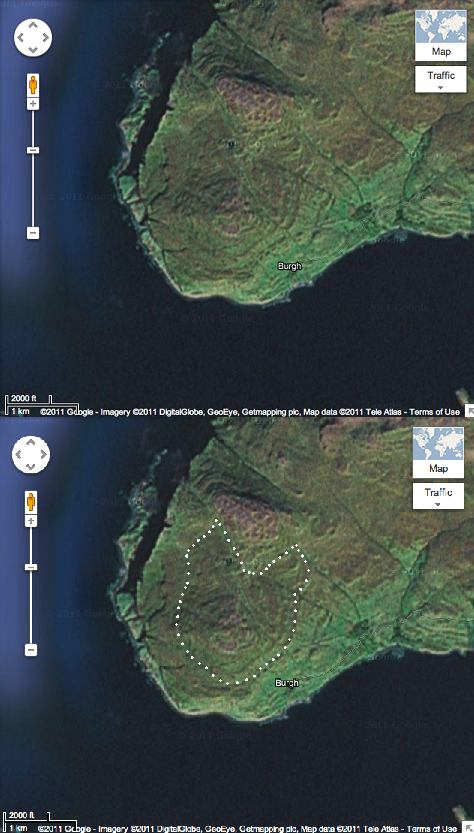The Chi Rho or XPI page
Since it has been raining here for several days, I’ve had some spare time to assemble the pictures I wanted to use for this post. I’ve taken an interest in Celtic art for some time, I always found it intriguing. After some time, I realized that there were heads and faces in many of the designs. Not only the ones which are obvious but others as well, often made up of triskles or other swirling designs. The theme of double heads is seen often. Sometimes it’s one head, but if you turn it over, it becomes a different head. Sometimes it’s two men. Sometimes a man and a woman. The two men are the Summer and Winter lords, the man and woman the goddess and her consort.
At the very end of a Celtic art book named Celtic Art by Ruth and Vincent Megaw, there is a picture of the Chi Rho or XPI page in the Book of Kells, and I wondered if Lugh/Cernunnos, or Summer lord -Winter lord had made it to the monasteries. I have a colour copy in a book named The Book of Kells, text by Sir Edward Sullivan. A reproduction of the 1920 version. However, I found a clearer picture on-line. This book has been connected to St. Columba, but it has never been proved. He is said to have worked in a scriptorium in a monastery in Ireland, and that there was a dispute about a manuscript Columba borrowed and copied. Apparently hostilities broke out and several people were killed, resulting in Columba’s exile to Iona.

However, the experts say this book dates about 800 CE, and St. Columba died in 597 CE. I don’t know who created this page, but he knew Ogham and all its meanings, and I think he may have left us a picture of a real Druid. St. Columba was from the Druid tradition, that’s why he is called a Crane Cleric. The crane being Cygnus, and connected to Manannan and his Crane Bag in which he kept his treasures. The treasures being the Ogham tract, including the vowels, consonants and diphthongs, plus the rolled up strip of the Whale’s back. The beginning of Columba’s name is Col. Coll is the Hazel, the Hazels of Wisdom.
The early Church in the UK and Ireland was the Culdee Church. It believed in God, Jesus, Mary, John the Baptist, and followed the Apostles. At the same time they still kept to their old Druid traditions. Most of the men and women connected to the early Culdee Church came from Druid backgrounds, and were already educated in their own traditions before entering a hermitage or monastery. These monasteries had both men and women, and both could become scholars. There was equal rights among them, they could even marry and have children. The earliest Christian writings in the Culdee Church were on Ogham sticks using Ogham, and later on velum and written in Greek. The Druids used Greek also, and Iona was once a Druid mystics’ retreat.
No one has ever disputed that this is the most marvelous page. Everyone is taken by the knot work, triskles, circles, etc. but no one has ever described the following, as far as I know, because no one knew that it was there. I have seen many of the formations before, but didn’t know their significance until now. According to the art book, this page is supposed to say XP, the first two letters of the Greek word Christos. But this artist actually has spelled the word Christos and quite a bit more. According to my Book of Kells, it says XPI, short for the Latin Christes. But this artist used Greek, he used it on another page also. The Druids spoke Greek long before Latin ever came to the British Isles, and I’d say this person came from the Druid tradition even if it was in 800 CE.
The basic layout for this page is similar to the XPI page from the Lindisfarne Gospels. We have the big X looking very bird-like, which is meant to be Cygnus, The Swan. Two arms of the X become a turban on an astronomer/astrologer or Druid. I say astronomer and astrologer because he is wearing the propheta head-gear.(1) On this page the legs of the bird are a straight staff joined to a staff with a curl in it, and a shape like a backward L. Both pages are very beautiful, but the one from Kells has a great deal more detail, and the hidden Ogham, which the one from Lindisfarne doesn’t have, although it does have small hidden pictures.
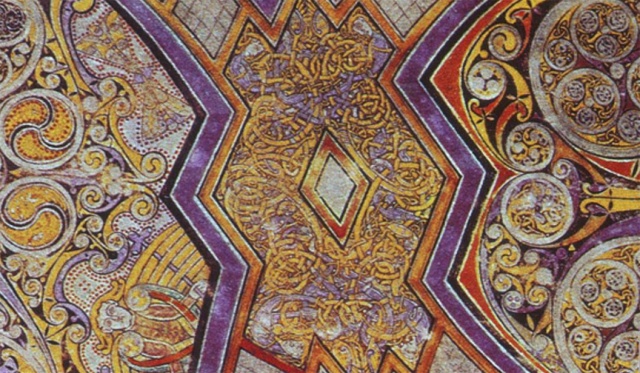
The first thing you notice on this page is the big X. It has the lozenge or diamond of the ‘hidden secret’ symbol in the centre of it. The angles of the smallest lozenge or diamond are 60° and 120°. Two equilateral triangles back to back. I call this the Double Godhead, because of all the double faces in Celtic art which are usually, but not always, two men. These are the Summer lord and the Winter lord, the two halves of the year, the dark half and the light half. In fact, the artist has gone out of his way to embellish this lozenge with knot work and four men entangled in the knotwork. They represent the four major divisions of the year, the Equinoxes and the Solstices. The whole thing becomes a much bigger diamond shape. Some time ago I discovered that the number four is connected to this shape and the ‘hidden secret’. Here as well. The artist has hidden four letters in the X and has applied Ogham meanings to them. The letters are C, H Ss, and T. Ss because he has used it twice to spell Christos, but it has meaning in Ogham as well. The statement, which St. Columba is said to have made about Jesus being his Druid becomes even clearer on this page. The C is the first letter in Christos but is also the ‘turban’ on what I have been calling a Druid.

The C is the two right arms of the X. C is for Coll, the Hazel, the Hazels of Wisdom which is another way of saying Druid knowledge. Jesus is said to have studied with the priests in Egypt. When he was only young, he was debating with the rabbis at Temple. Well educated even by then, and he was a great orator.
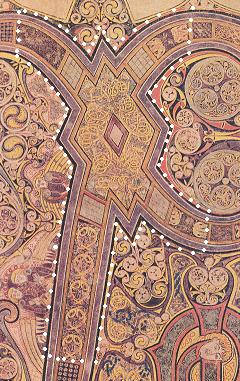
The H is right in the middle of the big X, and is comprised of the diamond and part of the four legs of the X. Right up to where the dark squares with the flowers in them are on the two left legs, but not including them. The flowers are wild Asters in the dark squares, it represents the time after September 21, the start of the dark half of the year. On the long leg of the big X, the light grey square is April, and the rings are May, June, July, August and September. In this case the dark square with the Asters is October, the next ring down is November and the point is December. Church tradition has Jesus born in December. The centre diamond is January, the darker border around it is February, and the part with the gold knot work is March.
The H is for Huathe, the Hawthorn. Its month is April, and that is when Easter usually falls. It is also the month which starts the light half of the year after the Spring Equinox. The first festival in the light half of the year is May 1, when we get Maypoles traditionally decorated with Hawthorn flowers. Garlands were also made with these to decorate the houses. Joseph of Arimathea planted a Hawthorn staff at Glastonbury Tor, it grew and flowered. This letter is connected with a period of waiting, restraint and chastity. Jesus spent forty days in the wilderness before his last visit to Jerusalem.

The Ss is an S used twice. The top part starts on the left hand top part of the X, moves through the diamond and ends with the bottom part of the C. Ss is for Straif, the Blackthorn. The English word, strife, comes from this. It has to do with overcoming great odds with optimism, bringing balance out of chaos…………………much can be said about this in connection with Jesus. You can fill in all your own blanks, since this topic could go on for pages.
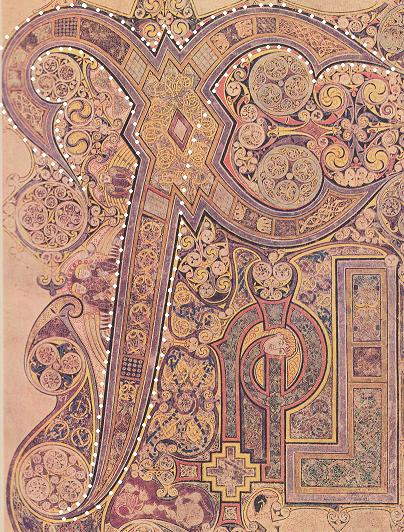
The T is the top of the S, the top of the C and the long leg heading for the bottom left hand side of the page. T is for Tinne, the Holly, which became the Holy Tree because people associated the Holly leaves with the Crown of Thorns. But that isn’t correct. It is the Holy Tree because the cross Christ was nailed to was T-shaped. The Roman’s used a T-shaped device for crucifixion, not the Christian cross we see now. This monk knew that.
Holly is said to be best in the fight, not only spiritual but because spear shafts were made from Holly, and the most important thing about throwing a spear is balance. So it also speaks of equilibrium, and the spear which pierced Christ’s side, but it also speaks of all the other spear imaging we see with Lugh, Wodin and many other Sun gods. Holly is also a symbol of fertility, and here the long point of the T is placing an egg on the Mound of Creation which, as in the book from Lindisfarne, has the head of an ibis. This is that wee story: Thoth as the Ibis laid an egg on the Mound of Creation, which was Hathor as the Milky Way. From the egg, Ra, the Sun god was born. Thoth as the Ibis is Cygnus, which sits on the Milky Way.
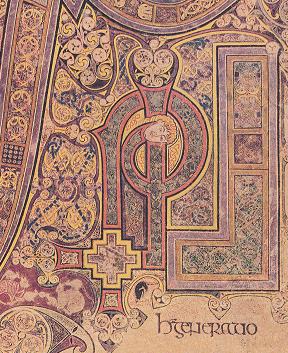
The O, I and R are at the bottom of the page. What is usually referred to as P is actually a glyph, making up P (for the casual observer), R and O. In very old manuscripts P was often written more like a B. But the monk has used a wake up device here to alert you to the hidden depths. Not only do the letters O, I, R belong to the word Christos, but it is also the name of an Ogham letter, Oir or the Spindle tree, whose symbol in the Ogham tract is a square with its corners turned to the cardinal points. I call this the Square of Enlightenment. The O is shaped like a stepped square and is holding together the two legs of the R, showing that these two belong together. The I is the shape which looks like a backward L.
For O he has used Oir, the Spindle. It is connected to that sudden flash of insight and lightning. In fact, it was the clue to this glyph. He has made it stepped and yellow, suggestive of lightning. This is also the shape of the Andean Cross which is symbolic of the Southern Cross. This constellation was used by mariners, as was the Northern Cross which is Cygnus. Spindle wood was made into spindles, bobbins and pegs. In this picture he has pegged the two legs of the R together with it. A joiner or carpenter, which is what Jesus was. He is also connected to enlightenment. Although Jesus was not born on December 25, we celebrate his birth at this time of year because people continued to celebrate this time of the year. In England it was referred to as Yule, and it was to welcome the Holly Lord, who long ago was Cernunnos. We still refer to this time of year as The Coming of the Light. Today it has a multi-layered meaning which comes to us from the time when people first took note of this return of longer days. A tradition which has endured over many thousands of years.
The R is made up of two elements, but the monk has shown us that they belong together by joining them at the bottom with Oir. R is Ruis, the Elder, the end in the beginning and the beginning in the end, the Cauldron of Immortality. The two elements which make up the R are what looks like a P and an I. The P is Phagos, the Hook, old knowledge, old writing, and also a star watching – surveying instrument. The I is the measuring rod and is also a Rodman or Dodman. If both of these were astronomy and surveying devices, then it speaks of the Star of Bethlehem also.
The measuring rod is straight until it gets to the top where it becomes more circular in the space between the bottom of C and the top of P. There’s a face there made up of circles and triskles. He uses them in all his half hidden meanings. The head seems to be covered by a hood, and from the top of it there are two long antennas with balls on the ends. The right one sits over the I, and the left one becomes part of a torque sitting under the chin of another face made of more circles and triskles and bird shapes. This face is Cernunnos. He has two horns on his head, and Cernunnos was often shown wearing a torque. I’ll come back to him, but first look at the I which looks like a backward L.
The I is Ioho, the Yew, which stands for rebirth, everlasting and reincarnation. According to my Ogham book, the Island of Iona first started off as Ioho or Ioha, but that there was an error in transcription made in the fifth century, and it became Iona instead. This island is connected to reincarnation. Jesus is the new Cauldron of Immortality, symbolized by the Holy Grail, and he is connected to rebirth and everlasting. The early Church still believed in reincarnation, but I don’t think they do anymore. The, I, the monk has made is shaped like a carpenter’s square.
Below are examples of two types of bird shapes this monk used in his decorations.
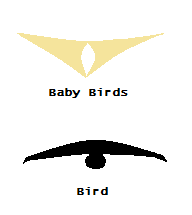
The monk also has many things made up of circles, triskles and other bird shapes, one of those things is ibis heads. On Thoth, it has the long curved bill. There is one under the top curve of the S. There’s a big ibis head close to the two angels, there’s wonderful knotwork inside of the head.. She has her beak curved around a circle, which I’ll call an egg, which has three small flying cranes inside it.

There is another ibis head close to the bottom of T, it’s sort of lying down. It also has its beak around an egg containing more small cranes. The two eggs they are holding have cranes at a different stage of development inside them. I say cranes because the bill is straight and long. These two heads are part of the Mound of Creation where there is another egg being deposited by the wingtip of Cygnus. This egg has yellow birds which are hardly developed and there is much more white in the egg. Here is that story about Ra again. Thoth as the Ibis (Cygnus) laid an egg on the Mound of Creation which was Hathor as the Milky Way. Ra, the Sun god, was born of that egg.
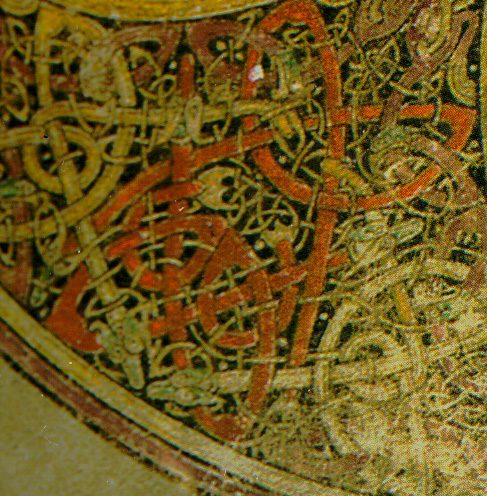
In the bottom left hand corner detail we see a baby (red serpents) emerging from the womb (white serpents). This would be Jesus who the Church says was born at the end of December. The point of the letter T is the end of December.
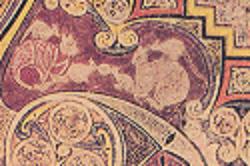
The fat cats and the little rats seem quite cozy together. They’re the abbots and the monks who fell in line with them. They are nibbling on the Pearl of Wisdom, the knowledge they were gaining in the monastery. No doubt, a wee Celtic joke on this artist’s part. The corner detail of this page also implies that two ibis hatched new cranes together. They are also inside some of the other circles, and in some cases there is what looks like a bird flying toward or away from you.
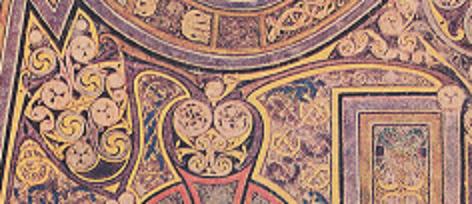
On the left, Cernunnos has two cranes close to the top of his head, they make a sort of crown. There are two more on his cheekbones. He has two flying birds making up his nose, and two more holding the plumes of his headdress. Some of these flying birds are light like the crane and some are dark like the raven.
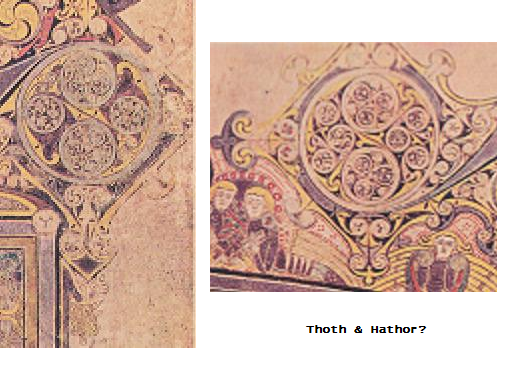 There are also heads of cattle there, also made up of circles, triskles and flying birds. One is between the angels. There are two more there making up the corners of the decoration around a circle with more cranes or ibis inside it. Unfortunately the outside one was cut off below the eyes. The one on the left is hanging off the Druids earring, close to the top of the I. This could be Taurus, or a connection to Bull El/ El Elyon, who was the god Enlil of the Sumerians. Elion is a Welsh name for God, it is still in the dictionary, although I’m told that it is seldom used. It was Enlil who taught people to farm, he put them to work in the Garden of Eden. At one time, the oldest cult figures found were small stone bulls from Mureybet, home of Jasmine, whose descendents made their way to the UK and Ireland, and were found at Skara Brae in the Orkneys. As far as I know, Mureybet still stands as the oldest farming community anywhere. The two cattle above could also be symbolic of Thoth and Hathor, both are shown with cattle horns, and both often have the Moon above their heads. Bulls, male goats, rams and harts or roebuck are all connected to ancient Sun gods. There was a great deal of cattle veneration in ancient times, from the Indus Valley to Ireland. Cattle are still sacred in India, and Celts loved owning large herds of cattle, which they often stole off one another. The Wessex lords are also believed to have been cattle barons, and my guess is that the folks at Ness Brodgar were also. There were a great many cattle bones found there.
There are also heads of cattle there, also made up of circles, triskles and flying birds. One is between the angels. There are two more there making up the corners of the decoration around a circle with more cranes or ibis inside it. Unfortunately the outside one was cut off below the eyes. The one on the left is hanging off the Druids earring, close to the top of the I. This could be Taurus, or a connection to Bull El/ El Elyon, who was the god Enlil of the Sumerians. Elion is a Welsh name for God, it is still in the dictionary, although I’m told that it is seldom used. It was Enlil who taught people to farm, he put them to work in the Garden of Eden. At one time, the oldest cult figures found were small stone bulls from Mureybet, home of Jasmine, whose descendents made their way to the UK and Ireland, and were found at Skara Brae in the Orkneys. As far as I know, Mureybet still stands as the oldest farming community anywhere. The two cattle above could also be symbolic of Thoth and Hathor, both are shown with cattle horns, and both often have the Moon above their heads. Bulls, male goats, rams and harts or roebuck are all connected to ancient Sun gods. There was a great deal of cattle veneration in ancient times, from the Indus Valley to Ireland. Cattle are still sacred in India, and Celts loved owning large herds of cattle, which they often stole off one another. The Wessex lords are also believed to have been cattle barons, and my guess is that the folks at Ness Brodgar were also. There were a great many cattle bones found there.
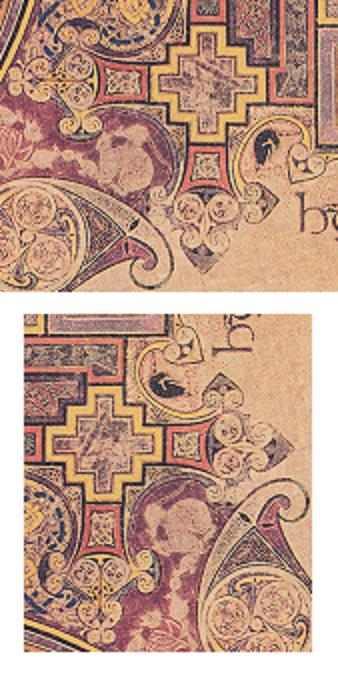 I think the artist may have cartoonish representations of Bran and Branwen. They are the Raven and the White/ female Raven. He is at the bottom of Phagos, the Hook – old knowledge, old writing. She is at the bottom of the measuring rod which could also be a surveying staff. They both look as if they are wearing a red hat with white knot work. I hesitate to say Fez, but they do look like that. She has blonde curly hair, has two trinity knots on her face, and a light coloured bird on her forehead. She also has a baby bird close to her curls on one side of her head. This would be Gwern, her son. The baby bird is two triskles joined at two corners. Lugh, Apollo and Wodin were also connected to ravens. I read that the small animal above Bran’s head is meant to be a badger with a fish. The fish is symbolic of Christianity, and Jesus was a ‘fisher of men’. But Bran, who is much older, is believed to be the Fisher King. Like the Fisher King, Bran was wounded in a lower limb, a wound which never healed, since it brought about his death.
I think the artist may have cartoonish representations of Bran and Branwen. They are the Raven and the White/ female Raven. He is at the bottom of Phagos, the Hook – old knowledge, old writing. She is at the bottom of the measuring rod which could also be a surveying staff. They both look as if they are wearing a red hat with white knot work. I hesitate to say Fez, but they do look like that. She has blonde curly hair, has two trinity knots on her face, and a light coloured bird on her forehead. She also has a baby bird close to her curls on one side of her head. This would be Gwern, her son. The baby bird is two triskles joined at two corners. Lugh, Apollo and Wodin were also connected to ravens. I read that the small animal above Bran’s head is meant to be a badger with a fish. The fish is symbolic of Christianity, and Jesus was a ‘fisher of men’. But Bran, who is much older, is believed to be the Fisher King. Like the Fisher King, Bran was wounded in a lower limb, a wound which never healed, since it brought about his death.
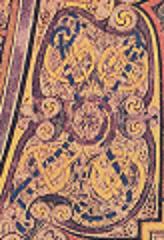
The X symbol for the sacred place is in the knot work between the leg of T and the R. The big X makes the whole page the sacred place, but the area in which the blue X is, looks like the Station Stone quadrangle at Stonehenge, including the Temple in the middle, and the Station Stones at the ends of the X.

To me, one of the most marvelous things one the page is the Druid. The C of Christos now becomes the headdress on the Druid. He has two big circles for eyes which have trinity knots in them, and the bridge of his nose is made up of ibis. Two big ones and two small ones. The tip of his nose is below the small ones, and his nostrils flare out into circles. Below the nose he has a moustache which also flares out in circles. His mouth is below the moustache, and is made up partly by two cranes whose beaks run down into his beard. His beard is mostly curly but the centre bottom part is divided and turned into knot work, which has been made into three diamonds inside one another with two parallel lines crossing two parallel lines woven into the diamonds, and they make up the symbol for the hidden secret. There are three diamonds inside one another and then the parallel lines inside the smallest one. This is exactly like the design on the Wessex lords ‘breast plate’, which has four diamonds inside one another. The outside one contains triangles, and the centre one the two sets of parallel lines. (2)
There are three ibis above one of the Druid’s eyes. The red band below his turban looks like an M when he is facing you, but looks like an E when the page is right side up. The artist could be suggesting that this is Manannan since the M shows up when he is facing you, but this is also the MEW3 device as you turn the page around. This device is symbolic of the four divisions of the year and also the four cardinal directions.
The headdress of the Druid is made of the letter C, Coll, the Hazel, the Hazels of Wisdom, that’s why I think he is a Druid. I think what he has on his head is a sort of turban with long tails flying behind, but they give the same impression as the headgear on the Hittite hieroglyph for propheta. (1) A prophet in ancient times was usually an astrologer, hence an astronomer. Perhaps it was only a long piece of cloth, which is what most turbans are made up of. In this case it is embellished with the big diamond. The ‘breast plate’ found in the Bush Barrow (2) measures 71/2″ by 6 1/2″ according to Prehistoric England, but I’ve also seen 7″ by 6″. If you tied a scarf around your head and connected it with the gold ‘breast plate’, you would pretty much look like this Druid. You’ll have to add a beard, moustache and large round earrings, and don’t forget the braided effect in the beard.

The monk is there as well, above the Druid’s head. The end of the S is over his head, looking somewhat like the cowl on a monk’s habit, particularly if you put your fingers over the area I have painted in. He has a moustache and a little curly beard which is divided in two at the bottom. There are baby birds close along the edge of his hood. Sheltering Druid children up in Iona? His eyes are very prominent and he has used Bardic values here. The left eye has two which is duality and polarity, as above so below, which puts us back with astronomy and the calendar, but also has all sorts of esoteric meanings connected to it. Duality because he was mixing two separate traditions. This person was as much a Druid as a Christian monk. His right eye is the Trinity. Past, present and future, or chaos, balance and creative energy. Or Creator, Sky Father, Earth Mother. Or Kether, Chokma and Binah. Or Father, Son and Holy Ghost. Or all of those depending on his education. The egg is his brain or mind, it includes the crane.
It’s difficult to see what is in the circles, but the large one and the small one seem to have the same design as the two on the Druid’s forehead. The ibis is there making up the back of his skull and has an Ogham, the three short yellow lines. It says Holly, best in the fight, but he has it on the ibis, so he thinks his Druid knowledge is best in the fight. Or possibly he is referring to astronomy and Cygnus. Since the ibis is the back of his skull, perhaps he is saying it is bred in his bones. The S in this case was Ss for Straif, overcoming great odds with optimism, making balance out of chaos. Certainly sounds like St. Columba, I’m not surprised that he got on so well with the people up in Iona. Iona was a Druid mystic’s retreat long before Christianity.

The artist has used and shown the last five letters of the Ogham tract or Forfeda, among others. The two parallel lines crossing two parallel lines with the lozenge or diamond in the middle, which I call the hidden secret. The Hook, the X or sacred place, Oir is the square with its corners turned to the cardinal points, and the Net which is in the light grey squares which are part of the big X and represented April. It is connected to the Sea, the Moon and maternal connections. The symbol for the Net is usually three squares by three squares, although I have seen two by two, three by three and four by four. This monk used four by four, and if you put these four light grey squares together you get a square of eight units by eight units, a Square of Hermes. However, a four by four square can be created with the sixteen wind system as shown below. (3) (4) This was used to create mariners maps. The number four was sacred to Hermes. An eight by eight square gives you 64 small squares. 64 ÷ 4 = 16, that Mystery School number.
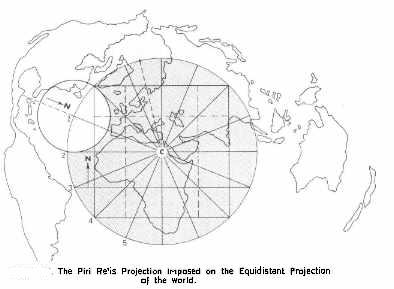
Knot work comes from Cording Lore which probably goes back to a time when people first had cording of some kind. Probably some bored soul on a rainy day with nothing better to do but make fancy patterns with his or her cording. Most of the patterns have names and meanings. On the XPI page the cording is gold inside the big diamond, it’s the measuring cord or Whale’s Back which is the line all the Ogham symbols sit on. He also has the measuring rod or surveying rod, the Hook which was a surveying or star watching device, a carpenter’s square, and the dividers which sit on the Druid’s nose and are made up by the beaks of the ibis.

When you turn the Druid upside down, the woven part of the beard now becomes a little man with big eyes, and he seems to have something long coming from the top of his head. Lugh- Cernunnos again. His head and arms rest on the curve. His ‘arms’ are actually two animal heads, one is a bird but I’m not sure of the other. Could be something doggie. Can’t see the detail well enough, but the whole thing does look like the Trilithon Horseshoe at Stonehenge.
I can’t see some of the smaller detail either, so he may have more messaging in that. However, I can see that some of the interlacing is made up of snakes, usually in pairs, and there are snails there also. Some are on the Druid’s face…….. think abstract. One of the more interesting snake configurations is at the bottom left hand corner. Two light coloured snakes and two red snakes both make a lozenge or diamond formation. Symbolic of the white and red serpent lines? If this is Jesus being born, then he would be of the red serpent line, or the Rose Line as it is sometimes referred to. Oddly enough, so were the Druids. The red dragon of Wales is still symbolic of the red serpent line. The history of these two family lines comes from very ancient times and are connected to Ea/Enki and El/Enlil.
It is very interesting though that the monk shows both the ibis and the crane. Which makes me think there must be some connection there. It is very possible that their original knowledge came from Egypt. Thoth was the Ibis, and he certainly had all the attributes associated with Stonehenge. Astronomy, surveying, mathematics, writing, healing and equilibrium or balance. And a really interesting Wing String! (5)
Some of the elements of these manuscript pages, such as the humans, were considered rather childish, and everyone is still scratching their heads about the figure of St. John with hands for feet. (6) It takes a different way of seeing, and since most folk are so busy looking at the triskles, spirals and interlacing………..they don’t ‘see’. They can’t see the forest for the trees, and considering what is on this page, that’s incredibly funny. This is the most sophisticated use of Ogham that I have found so far, and likely there is more messaging in the smaller detail, it’s just too small for my eyes. A few days with the real page would likely clear that up, although it is not likely I’ll ever get to see it. I wish!
Most art lovers drool over this page, and most of them probably couldn’t put into words why they feel this way. Oh sure, we can all wax lyrical about the triskles, spirals and interlacing, but there is so much more there that we recognize somewhere deep inside us, subconsciously. Something our DNA recognizes, but out modern way of thinking has buried it for a long time.
It’s interesting to note that the knot work in the Druid’s beard makes the same formation as the Wessex lord’s ‘breast plate’ which has been dated c1900-1600 BCE. It was in a grave for at least two thousand years before this page was made. If you were to extend the net on the ‘breast plate’ it would give you the same formation in the Druid’s beard. The Wessex lord’s large gold lozenge may actually be a real Stonehenge artefact. The logo, if you like. And I think that originally came from the surveying for the Aubrey Holes. (7) I think that Julius Caesar may have had it correct, the Druids started in the UK and Ireland. When I started down the White Trail, I was not looking for Celts and their Druids, but ran into them just the same. The Wessex lord, from the Bush Barrow, with his interesting mace head was likely the Archdruid of his time, after all, his mace head is the original Druid’s Egg. Did he wear his gold lozenge on top of his turbaned head? A forerunner of the gold hats?
In my article Cygnus, Thoth, XPI and the Brodgar Complex, I showed how this page and the XPI page from Lindisfarne Gospels connected to the Orkneys with its ancient astronomers, surveyors and navigators. Both Iona and Holy Island or Lindisfarne are sites belonging to the Cygnus that Derek Cunningham found on the landscape of Scotland. These two pages are a record of that ancient surveying, and tell us that it was the Orkneys which became the Mound of Creation. The place where astronomers, surveyors and navigators existed in ancient times. Navigators because on the page from the Book of Kells, we find both Cygnus and the Southern Cross, both these constellations were used for navigation. What is really amazing is that all the ancient constructions on the Orkneys were created about three to four thousand years before these pages were made. If Derek Cunningham is correct with his dates for Cygnus being placed on the landscape of Scotland, then that was eight to ten thousand years before these pages were made. It’s obvious that there were still people connected to the early Church who knew about this history. And what about the Summer lord and Winter lord? which is what made me look at this page in the first place. They are there also. Lugh and Cernunnos.

References
The Book of Kells, described by Sir Edward Sullivan, however he writes nothing about what I have described
The Celtic Tree Oracle by Liz and Colin Murray
The Encyclopedia of Celtic Wisdom by Caitlin and John Matthews
(1) Cygnus, Thoth, XPI and the Brodgar Complex, by Joan Rankin
(2) The Bush Barrow Treasures, by Joan Rankin
(3) Maps of the Ancient Sea Kings, by Charles Hapgood
(4) Ancient-wisdom.co.uk
(5) Following the White Trail to Stonehenge Part IV by Joan Rankin
(6) The Amazing Book of Kells by Joan Rankin
(7) Following the White Trail to Stonehenge Part I by Joan Rankin
Pictures
XPI page from Wikipedia under The Book of Kells
Detail of the large diamond by Yetac
Forfeda by Joan Rankin
Mapping device from Ancient-wisdom.co.uk. This was originally in Charles Hapgood’s book Maps of the Ancient Sea Kings.
